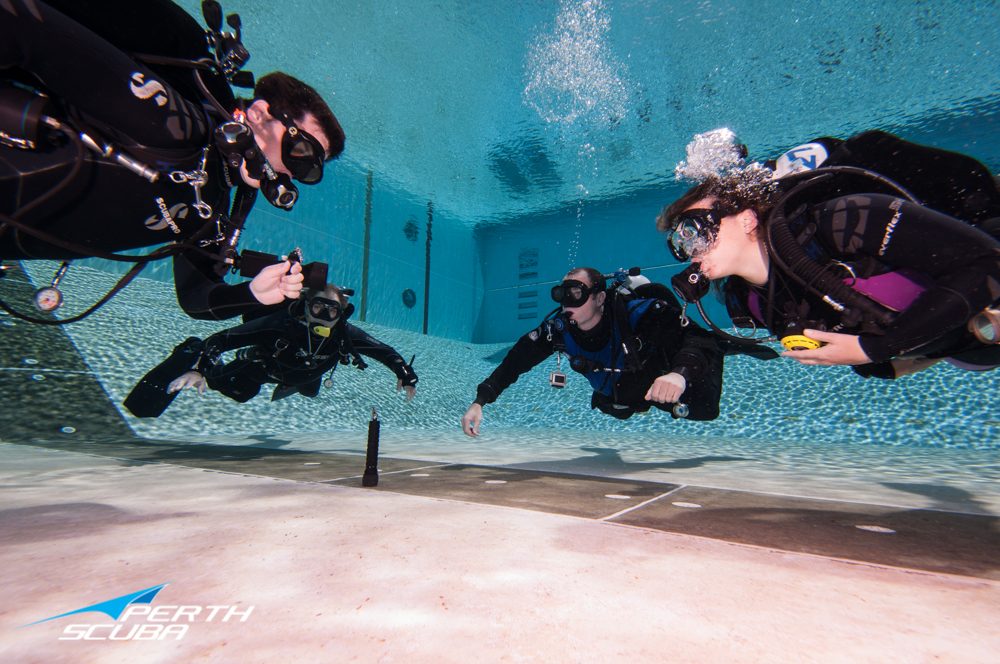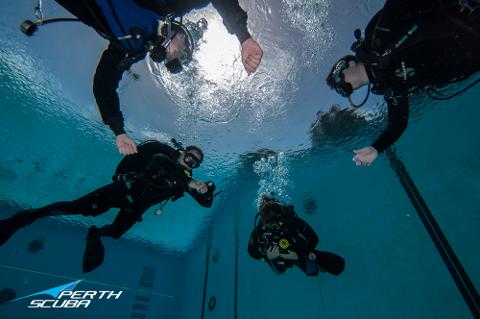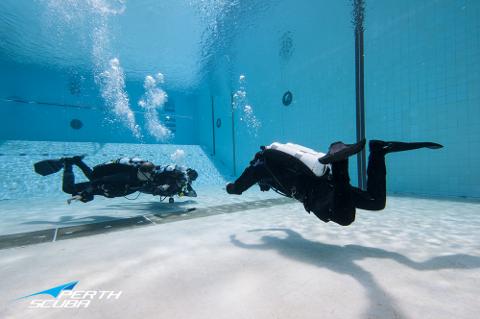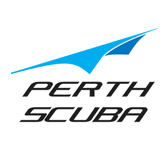GUE Fundamentals Course



- Duration: 4 Days (approx.)
The GUE Fundamentals course is designed to cultivate the essential skills required by all sound diving practice, irrespective of level or environment.
A pre-requisite for all GUE classes, except Recreational Diver level 1 course, GUE Fundamentals performs a three-fold function:
- it provides the recreational diver, who does not desire further diver training, with an opportunity to advance his/her basic diving skills, thereby developing more comfort, confidence, and competence in the water
- it provides the diver with aspirations of more advanced diver training with the tools that will contribute to a greater likelihood of success
- it provides non-GUE trained divers with a gateway to GUE training.
Prerequisites
- Must meet GUE General Course Prerequisites
- Must be a minimum of 16 years of age
- Must be a certified open water diver from a recognized training agency
Duration
The GUE Fundamentals class must be conducted over at least four full days, encompassing both classroom and in-water work. Classes in which the student-to-instructor ratio (both in water and surface) does not exceed 3:1 may be conducted in no fewer than three full days. Course requirements include a minimum of ten hours of academics and five in-water sessions; at least two of these dives must include a depth of at least 25 feet / 8 meters.
Includes
- Instructor fee
- classroom tuition
- pool entry fee
- Enriched Air Nitrox fills
- Cylinder and weight hire
Not included
GUE registration fee - $95 USD payable to GUE
Instructor Flights - payable to Instructor at beginning of the class (apportioned equally between all students)
Instructor Accommodation - payable to Instructor at beginning of the class (apportioned equally between all students)
Course Limits
- General Training Limits
- Student-to-instructor ratio is not to exceed 8:1 during land drill or surface exercises, but cannot exceed 4:1 during any direct in-water training In-water ratios should be adjusted downward to account for bad conditions and/or poor visibility.
- Maximum depth 60 feet/18 meters
- No decompression
- No overhead environment diving
Course Content
Combining lecture and in-water sessions, this course focuses on cultivating the basic skills required for all sound diving practice. It is focused on increasing diving fun by reducing stress and increasing diver proficiency through proper control of buoyancy, trim, propulsion, teamwork, and other GUE principles. Course requirements include a minimum of ten hours of academics and five in-water sessions; at least two of these dives must include a depth of at least 25 feet / 8 meters.
Required Training Materials
- Doing it Right: The Fundamentals of Better Diving. Jarrod Jablonski, GUE, 2001, High Springs, Florida.
- GUE Fundamentals Workbook.
- GUE organization
- Why GUE Fundamentals?
- Diving proficiency
- Buoyancy and trim
- Streamlining and equipment configuration
- Propulsion techniques
- Situational awareness
- Communication
- Breathing gas overview
- Decompression overview
- Dive planning and gas management
- Diver preparedness
Land Drills and Topics
- Dive team protocols
- S-drill and valve-drill
- Equipment fit and function
- Propulsion techniques
- Pre-dive drills
- Surface marker deployment
- Unconscious diver recovery
Required Dive Skills and Drills
- Demonstrate proficiency in safe diving techniques; this would include pre-dive preparations, inwater activity, and post-dive assessment.
- Must be able to swim at least 300 yards/275 meters in under fourteen minutes without stopping. This test should be conducted in a swimsuit and, where necessary, appropriate thermal protection.
- Must be able to swim a distance of at least 16 yards/15 meters on a breath hold
- Demonstrate awareness of team-member location and a concern for safety, responding quickly to visual cues and dive-partner needs.
- Efficiently and comfortably demonstrate how to donate gas to an out-of-gas diver.
- Efficiently and comfortably demonstrate how to donate gas to an out-of-gas diver followed by an ascent to the surface, utilizing minimum decompression.
- Comfortably demonstrate at least three propulsion techniques that would be appropriate in delicate and/or silty environments; students should demonstrate comprehension of the components necessary for a successful backward kick.
- Demonstrate a safe and responsible demeanor throughout all training.
- Demonstrate proficiency in the ability to deploy a surface marker while using a spool.
- Demonstrate proficiency in underwater communication.
- Demonstrate basic equipment proficiency and an understanding of the GUE equipment configuration.
- Demonstrate dive-rescue techniques, including effective management of an unconscious diver. Differences between the management of an unconscious diver and a convulsing diver should be noted.
- Demonstrate a comfortable demeanor while swimming without a mask, in touch contact.
- Demonstrate good buoyancy and trim, i.e. approximate reference maximum of 30 degrees off horizontal while remaining within 5 feet/1.5 meters of a target depth. Frequency of buoyancy variation and the divers control of their buoyancy and trim are important evaluation criteria.
- Demonstrate aptitude in the following open-water skills: mask clearing, mask removal and replacement, regulator removal and exchange, long-hose deployment.
- Demonstrate safe ascent and descent procedures.
- Demonstrate proficiency in executing a valve drill.
- Demonstrate proficiency in four propulsion techniques that would be appropriate in delicate and/or silty environments; students should also demonstrate competence in the backward kick. *
- Demonstrate proficiency with a primary light by using it during all skills except SMB deployment.*
- Demonstrate efficient deployment and stowage of a reserve light.*
- Demonstrate an efficient valve drill with double tanks.*
- Demonstrate good buoyancy and trim, i.e. approximate reference maximum of 20 degrees off horizontal while remaining within 3 feet/1.0 meters of a target depth. Frequency of buoyancy variation and the divers control of their buoyancy and trim are important evaluation criteria.*
*Skills and drills 18-22 apply only to students seeking admittance into Tech or Cave training. These students must perform skills 16-19 at a grade of 4 or above to qualify for registration into the Tech or Cave curriculum (see 1.3.1 Outline of Diver Training).
Equipment Requirements
Each student should have, and be familiar with, all of the following required equipment.
- Tanks/Cylinders: Students may use dual tanks/cylinders connected with a dual outlet isolator manifold, which allows for the use of two first-stages. Students may also use a single tank/cylinder with a K, H, or Y-valve.
- Regulators: One of the second-stages must be on a 5- to 7-foot/1.5- to 2-meter hose. One of the first-stages must supply a pressure gauge and provide inflation for a dry suit (where applicable).
- Backplate System: A rigid and flat platform, of metal construction with minimal padding, held to a diver by one continuous piece of nylon webbing. This webbing should be adjustable through the plate and should use a buckle to secure the system at the waist. A crotch strap attached to the lower end of this platform and looped through the waistband would prevent the system from riding up a diver’s back. A knife should be secured to the waist on the left webbing tab. This webbing should support five D-rings; the first should be placed at the left hip, the second should be placed in line with a diver’s right collarbone, the third should be placed in line with the diver’s left collarbone, the fourth and fifth should be affixed to the crotch strap to use while scootering or towing/stowing gear. The harness below the diver’s arms should have small restrictive bands to allow for the placement of reserve light powered by three in-line c-cell batteries (where necessary). The system should retain a minimalist approach with no unnecessary components.
- Buoyancy Compensation Device: A diver’s buoyancy compensation device should be back-mounted and minimalist in nature. It should come free of extraneous strings, tabs, or other material. There should be no restrictive bands or “bungee” of any sort affixed to the buoyancy cell. In addition, diver lift should not exceed 50lbs for a single tank and 80lbs for double tanks. Wing size and shape should be appropriate to the cylinder size(s) employed for training.
- At least one time/depth-measuring device
- Mask and fins: Mask should be low volume; fins should be rigid, non-split
- At least one cutting device
- Wet Notes
- SMB
- One spool with 100 feet/30 meters of line per diver
- Exposure suit appropriate for the duration of exposure
- Double cylinders with isolation manifold, and appropriately sized double-tank buoyancy compensation device.*
- One primary light: A primary light should be minimalist in design; its power source should consist of a rechargeable battery pack residing in a canister powering an external light head via a light cord. Primary lights should produce the equivalent output of 50-watt halogen/10-watt HID lighting or greater.*
- Two reserve lights: Reserve lights should be powered by two or three in-line non-rechargeable C-cell batteries, with a minimum of protrusions and a single attachment at its rear. The light should be activated and de-activated by twisting the front bezel.*
*Required equipment 12 through 14 applies only to students seeking admittance into Tech or Cave training.
Note: Prior to the commencement of class, students should consult with a GUE representative to verify equipment requirements. Whether or not a piece of equipment fulfills GUE’s equipment requirement remains at the discretion of GUE and its instructor representatives. Participants are responsible for providing all equipment or for making provisions to secure the use of necessary equipment before the start of the course. In general, it is better for the student to learn while using his or her own equipment. However, students should exercise caution before purchasing new equipment to avoid acquiring substandard equipment. Please contact a GUE representative at Perth Scuba prior to making any purchases.





